#afrolatinx
Text

VENUS DIVINE💋
#venus divine#@_jon.e#📸:@j_alexpromo#blackisbeautiful#blackwomen#blackbeauty#blackandbeautiful#blackwomenaregorgeous#blackandsexy#blacksensuality#blackfemininity#naturalistas#afro#afrohair#afrocurls#afrocentrichairstyles#afrolatinabeauty#afrolatinx#blackgirlmagic#blackgirlbeauty#blackgirlaesthetic#brownskingirls#brownskinbaddies#beautifulblackpeople#blackpeopleworldwide#blackisavibe#blacktumblr
3K notes
·
View notes
Text
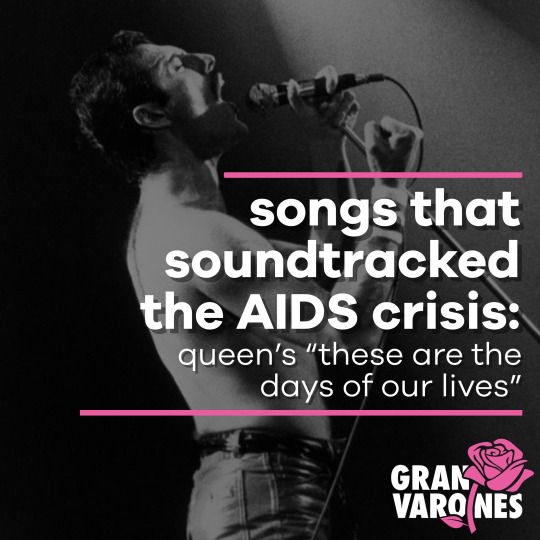
The early 1990s were a pivotal era in popular culture, significantly marked by the escalating AIDS epidemic. For Queen, one of the most celebrated rock bands of the 20th century, the impact of AIDS was deeply personal.
By the release of "Innuendo," Queen's fourteenth studio album, Queen had established itself as one of the world's most iconic and enduring rock. With a string of hits and groundbreaking albums throughout the 1970s and 1980s, the band had garnered a reputation for its eclectic musical style, theatrical performances, and Mercury's charismatic stage presence.
However, this was a period of transformation and challenge for the band. Mercury's declining health due to AIDS complications, though a closely guarded secret until near the end of his life, became a subject of speculation and media scrutiny, reflecting the stigma and fear surrounding the disease at the time.

Released in the US on September 5, 1991, on Mercury's 45th birthday, "These Are The Days of Our Lives" served as the 4th single from "Innuendo." Written by band member Randy Taylor, the song evokes a melancholic sense of nostalgia and longing for days gone.
The accompanying music video for "These Are the Days of Our Lives," released as his health deteriorated, featured a frail Mercury and accentuated the song's emotional impact. It was one of the last times Mercury appeared on camera, making the video a haunting yet graceful farewell from the beloved artist.
youtube
In the closing scene of the music video, Mercury delivers the line, "I still love you," with a direct gaze into the camera, and for many, it felt like a personal message from him.

Freddy Mercury's death on November 25, 1991, marked the end of an era for Queen and the music world. His loss also brought significant attention to the AIDS crisis and played a crucial role in raising awareness and fostering a more compassionate public discourse.
"These Are the Days of Our Lives" is a testament to Freddy Mercury's profound impact on music and his ability to connect with audiences through his artistry and humanity. The song remains beloved in Queen's discography, symbolic of their reach, impact, and legacy.
#granvarones#gay#queer#latinx#storytelling#afrolatinx#lgbtqia#aids#songs that soundtracked the aids epidemic#worldaidsday#Youtube
65 notes
·
View notes
Text

#photography#wlw#woc#latinx#portrait#afrolatinx#natural hair#boricua#sapphic#queer#pride#self portrait#black girl magic#wlwoc
502 notes
·
View notes
Text
I have known about Victoria Santa Cruz's work about as far back as secondary school but this is truly the most thorough and comprehensive article I've read on her work that does a great job of situating her in a broader, cross-cultural context; or in other words the "why" her work matters beyond borders.
Some powerful quotes that struck me:
"In a 2007 interview, Santa Cruz described how as a little girl, she had been playing with a group of friends when a new girl with blond hair joined them and stated that if Santa Cruz remained, she would leave. Her friends promptly told Santa Cruz to leave, which to her, exemplified who held power and who had the right to wield that power."
The author does a great job building context with this line:
"In the 1960s and 1970s, Black activists in the United States, like Santa Cruz in Peru and Paris, redefined and recreated what it meant to be Black. Black with a capital 'B' is about self-naming, self-defining, and self-determining, which can be seen in the work of Santa Cruz. It is, at times, biographical, exhibiting the arduous process she has endured to form an identity that isn’t controlled or concerned with outdated stereotypes and instead honors a rich heritage inherited and a [sense of self] not founded in shame."
Victoria Santa Cruz is originally from Perú, not the Caribbean, but as I touched on in a previous post, sharing this work is a part of a broader personal initiative to expand the narrative when talking about Latin America and the Caribbean and its diáspora.
#memoria ancestral#ancestral memory#victoria santa cruz#afrolatina#afrolatino#afrolatinx#peru#diaspora#diáspora#black studies#black studyblr#black diaspora#what i'm reading#perú#lima perú#lima peru
9 notes
·
View notes
Text
Let's talk about San Baltasar, the Wise King, Saint of Afroargentines.
I think it's extremely interesting how one of the biggest afrodiasporic cults native to Argentina is that of El Santo Negro (the Black Saint) St. Balthazar, the Wise King. Other syncretic saint cults make mention to african deities or saints with titles such as "The Queen of Rivers" or "The Queen of the Sea", making the deities involved easily identifiable, but this cult in particular is one of the most widespread across the black population of Argentina and yet the most elusive in regards to who may be behind the mask. At least, until you pay attention to the details.
The Church first introduced the cult of Catholic Figures and Saints such as San Baltasar (King Balthazar) or San Benito de Palermo (St. Benedict of Palermo, the Moor) as a way to control the enslaved population politically and culturally. Although their goal was to dissipate african religions and install catholicism among them instead, they underestimated black argentines: after much effort, the church allowed the enslaved faithful to organize socially and politically and perform dances, drumming and singing for the saints of their formed Cofradía (similar to a congregation, but including social and political structures within it, naming a king and queen or a president and other culturally and politically significant roles). Thanks to the passing down of african culture and customs through these organized societies and the syncretism within them, we can proudly say the church failed in their attempts. The african spirits are very much still an integral part of afroargentines' lives. Today, although it has spread across the country and beyond, the center of this cult is in it's origin, the capital city of Corrientes, Argentina, in a neighborhood called Cambá Cuá.
The cult to San Baltasar is clearly african in origin, although with indigenous (guaraní) influences, such as calling the saint Santo Cambá/Kambá (Black in guaraní language), calling his statues Cambára'angá (guaraní for Black Figure), and some dancers dressing up as indigenous figures like el pombero, among other things. Thus, it is an afroindigenous cult, developing amongst mixed descendants of african enslaved peoples and guaraní natives. The cult is also a local expression of the most african of customs: ancestral veneration. The festivities honor not only the Saint himself, but all the black ancestors before us who are present in pictures at the altar, and answer to the call of the drums. The color red, that covers the saint and adorns his followers, is the color of warriors and protection in African Traditional Religions. He's offered food and drink (such as wine and traditionally made sangría), and most importantly dance and drums. He is invoked and honored, along with the ancestors, through drumming and dancing, through La llamada a San Baltasar and Saludos de Tambores a los Santos Cambá (Calling Saint Balthazar and Drum Salutations to the Black Saints).
His festivities, held in Corrientes around Epiphany, from January 1st to the 6th, include dancing afroargentinean rhythms such as diverse forms of candombe and samba. Particularly, he was traditionally honored with a dance called bambula, a form of ring dance where women move in short and slow steps, barely lifting their feet, while men jump in the air, and where one singer sings a phrase that is then repeated or answered by the others present. This kind of dance is native to Congo and Angola, and widely practiced by enslaved people and their descendants in the Southern United States, the Caribbean, Brazil, Argentina and Uruguay. The music used to this day to petition favors, to invoke his spirit into his image and even dispel or call thunderstorms or other natural phenomena, is called charanda and includes drums, guitars and triangles. Just like in other afrodiasporic devotional and resistance dances, these dances involve Kings and Queens of the dance, a hierarchy of drummers including those called Master drummers, and a hierarchy of the drums themselves as Chico, Repique and Piano.
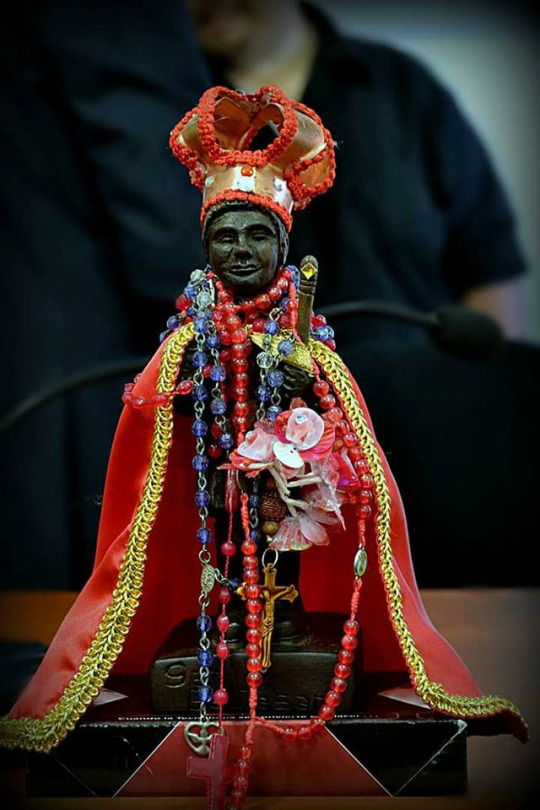
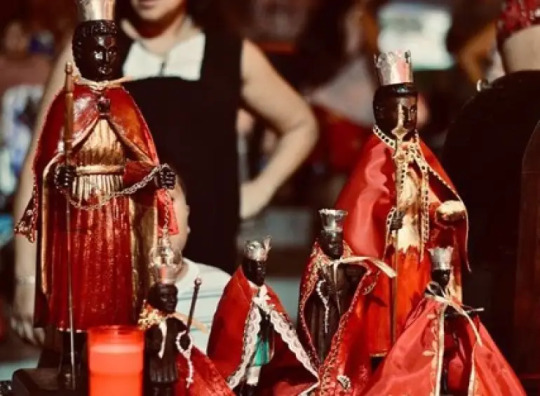
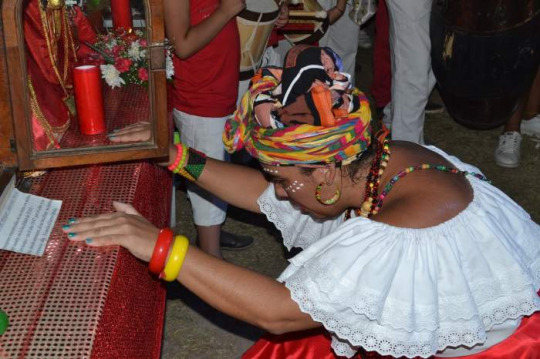


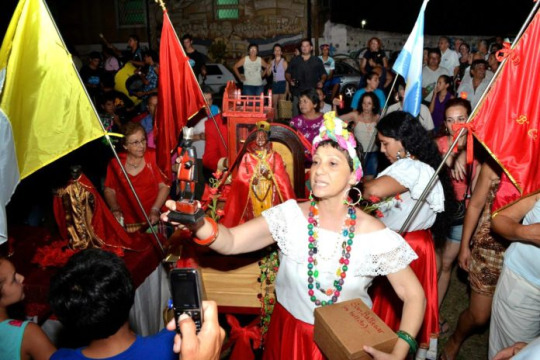
If you compare him to Xangó...
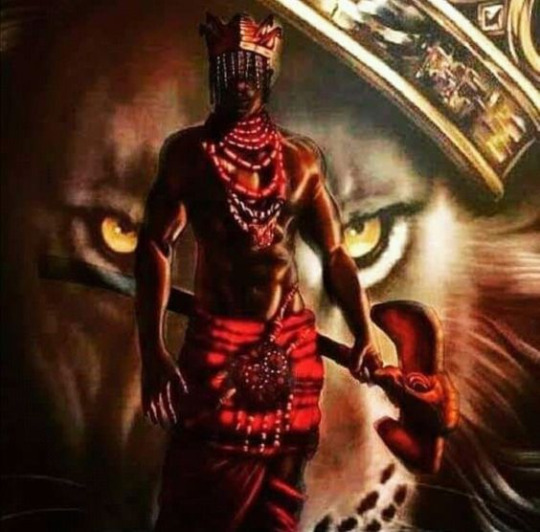
He carries a double-headed axe. He's often depicted wearing a crown. His colors are, surprisingly, also white and red, with gold accents. Also a King and a warrior, also associated with thunderstorms and fire, drums and dance. His followers also wear white and red beaded collares. Ringing any bells...?
Now, I am not saying they are the same Spirit, but there is an undeniable resemblance. You come to your own conclusions. It's kind of obvious that this afrodiasporic cult stems from either (a) a hidden, veiled cult to the orisha(s) or (b) a syncretic cult to african deities (not only orishas but maybe other african spirits too). There is, after all, strong ties not only to Yorubaland but also to Dahomey, Kongo, etc. Just in this instance, the spirit may resemble an orisha but the rhythms and dance are from kongo, so there is much more to it than just one or the other. There is a culture of resistance born from the union of Nations through music, faith and tradition.
Sources:
None of the images here belong to me: San Baltazar and festivities [1,2,3,4-6] and Xangó [1]
Festividad de San Baltasar : performances artístico-religiosas de la cofradía de la ciudad de Corrientes, by Cavalieri, Ana Belén, Universidad Nacional del Nordeste. Facultad de Artes, Diseño y Ciencias de la Cultura, 2018. Available for download at [Link]
San Baltazar, Historias de Corrientes at [Link]
The bamboula Lineage at [Link]
The Orishas, Indiana University at [Link]
#ATRs#afroargentina#afroargentines#afrolatine#afrolatinx#afrolatino#black saint#black saints#st balthazar#st. Balthazar#San Baltazar#Santería#shangó#xangó#santeria#african diaspora#african traditional religions#african diasporic religions#african diaspora religions#ADRs#san baltasar
20 notes
·
View notes
Text
#fashion#photography#music#style#love#black fashion#style icon#beauty#latina#solange knowles#afrolatina#nyc#selfie#hipster#fashion icon#afrolatinx#black hipster#natural hair#blackout#hip hop
32 notes
·
View notes
Text

money ain’t a thang 💰
follow me on tiktok / twitter / IG: @hilaryamii
#melanin#swag#beauty#blackout#blackfashion#new#model#fashion#afrolatinx#blackoutfriday#explore#popular#natural#makeup#skin#blacktumblr#blackwomen#Hilary Yami#Virgo
14 notes
·
View notes
Text

in 1993, you could NOT tell me that carmen electra was not going to be a major pop star. and that would probably have happened if the “pop starlet can dance her ass off” craze had not begun to wear thin.
born tara leigh patrick and rechristened carmen elektra by prince, electra released her debut and only album in a precarious time in music. pop/dance music was being replaced by grunge and hip-hop music at both radio and MTV playlists. even madonna’s hold on radio bad begun to loosen.
so when carmen electra released “everybody get up,” the live instrumentation pop/dance rap single, the sound was simultaneous behind and ahead of the moment.
youtube
“everybody get up” garnered some play on BET and MTV but not enough to send it up the pop chart - even with the backing of prince.
i wasn’t a huge fan of this song, i much preferred the previous single, the hip-house “go go dancer,” but i was captivated by this music video. this version of the music that is. the original edit didn’t feature carmen’s strongest asset - dancing. and as a lover of paula abdul and janet, who in early 1993 had either wound down an album’s promotion or were gearing up for a return, carmen filled that void. but i yearned for a more melodic song from electra.
"everybody get up." the song charted modestly on the billboard's dance chart in the spring of 1993. a final single was released but with prince's battle with warner bros. escalating, the promotion for electra's album became a casualty.
thirty years after its release and upon re-examination, i gotta say that miss carmen ate.
#louiesmixtape#90s music#music history#1990s#1990s music#carmen electra#prince#lgbtq#afrolatinx#Youtube
1 note
·
View note
Text
youtube
Two trans men in conversation about life, relationships, mental health, Taz’s music career, & more!
#tmoc#black transman#transman#houston#black tmoc#transgender#tpoc#afrolatinx#black trans people#podcast#blacktranslivesmatter#blacktrans#black trans men#black trans podcast#trans podcast#ftm#ftmpodcast#Youtube#black trans history#black history#black history month
4 notes
·
View notes
Photo

Swipe🔝Happy reading While Latinos in the United States are frequently referred to as "brown," this term does not adequately represent the range of skin tones and races found among the country's Hispanic population. These physical differences can influence how Hispanics are treated in the United States, including by other Latinos. Latinos with darker skin color report more discrimination experiences than Latinos with lighter skin color. The Floyd demonstrations inspired Latinos to challenge racism and anti-blackness in their neighborhoods. Part of Latinos' racial reckoning is letting go of the notion that "blackness is something else that is based in the United States" and "doesn't directly affect our Afro-Latino brothers and sisters." Latinos "need to stop acting as if our ethnicity shields us from any racial implications. Discrimination based on the color of skin has deep roots in Latino culture. But it doesn't have to continue for the next generation. I had to unlearn a lot of the messages I was fed as a child about beauty, self-worth, and skin color. We cannot "be strong" and achieve great political success on our own. The ideals and values championed by Dr. King serve as a source of inspiration for our nation's long struggle for justice, equality, and dignity. Acting distrustfully and violently against one another not only goes against these tenets but also prevents us from having a powerful, viable, united front against those who are actively working to undo the progress that has been done over the past 50 years. Simply by pouring out love, we can help others rise to higher levels. El Amor es contagioso y Tiene el mayor poder curativo. la Unión Hace la Fuerza. . . . . . #hispanicheritage #hispanicheritagemonth #hispanic #afrolatina #latina #blackgirlmagic #naturalhair #curlyhair #afrohair #afrolatino #melanin #afrolatinx #haitian #blacklivesmatter #nyc #explorepage #caribbean #cuba #blackwomen #melaninpoppin #afrolatinas #love #afrobeats #boricua #dominicana #model #afrodance #explore #hiphop #africa (at Miami, Florida) https://www.instagram.com/p/CjvMsvEgJ1Q/?igshid=NGJjMDIxMWI=
#hispanicheritage#hispanicheritagemonth#hispanic#afrolatina#latina#blackgirlmagic#naturalhair#curlyhair#afrohair#afrolatino#melanin#afrolatinx#haitian#blacklivesmatter#nyc#explorepage#caribbean#cuba#blackwomen#melaninpoppin#afrolatinas#love#afrobeats#boricua#dominicana#model#afrodance#explore#hiphop#africa
5 notes
·
View notes
Text

𝚅𝚎𝚗𝚞𝚜 𝙼𝚊́𝚛𝚚𝚞𝚎𝚣
#venus márquez#@rizosalsol#blackisbeautiful#blackwomen#blackbeauty#blackandbeautiful#blackwomenaregorgeous#blackandsexy#blackfemininity#septumpiercing#afro#afrohair#afrocurls#afrocentrichairstyles#afrolatinabeauty#afrolatinx#afrocolombian#colombiana#brooklyn#brooklynsfinest#blackgirlmagic#blackgirlbeauty#blackgirlaesthetic#brownskingirls#beautifulblackpeople#blackpeopleworldwide#blacktumblr
630 notes
·
View notes
Text

Today, we honor and celebrate the life and legacy of Hydeia Broadbent, a beacon of hope, courage, and relentless advocacy in the fight against HIV/AIDS. Hydeia was a warrior whose spirit and determination transformed the landscape of awareness and compassion for those of us living with HIV/AIDS.
From a very young age, Hydeia stood in the glaring spotlight of public attention, not for fame or recognition, but to challenge the stigma and misconceptions surrounding HIV/AIDS. Diagnosed with HIV at three years old, Hydeia was not expected to survive past age five. In 1987, almost a decade before the introduction of effective HIV treatment, this prognosis was pretty accurate for children battling opportunistic infections brought on by HIV.

Hydeia’s mother immediately became a fierce advocate and enrolled Hydeia in clinical trials to prolong her life. It was an extraordinary win during a time when HIV clinical trials did not include women, young people, and people of color.
A chance meeting with the late HIV advocate Elizabeth Glaser in 1988 at the National Institute of Health, where they were both receiving treatment, led to Hydeia becoming a public speaker. After telling her story worldwide, including on a TV special for Nickelodeon with Magic Johnson, 20/20, Good Morning America, and becoming one of the most memorable guests of the Oprah Winfrey Show, Hydeia had become the face of not just pediatric aids but the first generation of children born with HIV.

Hydeia’s powerful and unwavering voice broke through barriers of fear and ignorance. She spoke at schools, appeared on national television, and collaborated with organizations worldwide, sharing her story to educate others about the reality of living with HIV/AIDS. Her message was clear: HIV/AIDS does not define a person, and everyone deserves love, respect, and compassion.
Hydeia changed this world! She helped shape how we advocate for young people and Black women living with HIV. She changed hearts and minds, pushing society towards greater acceptance and understanding. She inspired countless individuals to get tested, to speak openly about their status, and to fight against the stigma that continues to surround HIV/AIDS.
As we remember Hydeia Broadbent today, let us honor her memory by continuing her work. Let us be advocates for change and champions for accessible treatment for all people living with HIV, especially young Black women. Hydeia’s fight is our fight, and in her memory, we pledge to keep the flame of her legacy burning bright.
Hydeia, rest in peace. Your legacy, a tapestry woven with threads of hope, love, resilience, and unyielding commitment to all people living with HIV, will continue to guide us until there is a cure.

Hydeia Broadbent
June 14, 1984 – February 20, 2024
#hydeia broadbent#granvarones#gay#queer#latinx#storytelling#trans#afrolatinx#aids#lgbtqia#black history month
23 notes
·
View notes
Text

#photography#wlw#woc#latinx#puerto rico#portrait#afrolatinx#natural hair#boricua#sapphic#pride#queer#box braids#self portrait#black girl magic#wlwoc#fashion
196 notes
·
View notes
Text

Santa Cruz understood the importance of being able to see oneself in their culture and the value of identity. Through her work, she was not only able to disavow the way that Blackness was seen, but she redefined Blackness. She refused to accept the position that Peru and the broader American society continuously forced Black individuals into and, by writing and producing plays, allowed others to reject those roles. [x]
#victoria santa cruz#ancestral memory#memoria ancestral#lima peru#lima perú#latin american art#arte latinoamericano#afrolatinx#afrolatina#afrolatinos#historia de arte#art history blog#performance#dance#danza#theater#theatre#teatro#photography#fotografía#photographie#diaspora#diáspora
6 notes
·
View notes
Text
That moment when you are Afro-Latinx ( me) 🥸🇹🇹🇦🇬🇻🇪
1 note
·
View note

